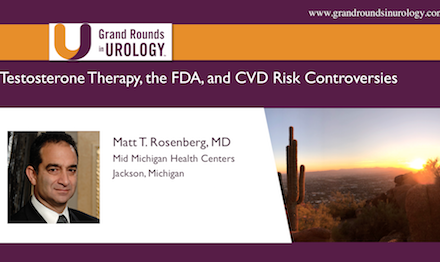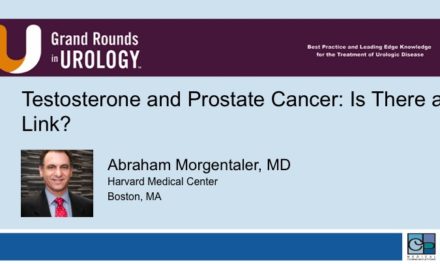Dr. M. Scott Lucia spoke at the 24th International Prostate Cancer Update on Thursday, February 20, 2014 on “Gene Expression Assays for Prognostic Value in Prostate Cancer” In his presentation, Dr. Lucia discusses the advantages of gene expression profiling to predict the potential for progression in metastasis and its limitations.
Presentation
Keywords: gene expression, biomarkers, GPS score, CCP score, GC score, biopsy
Cite: Lucia, M. Scott. “Gene Expression Assays for Prognostic Value in Prostate Cancer.” Grand Rounds Urology. January 6, 2015. Accessed Nov 2024. https://dev.grandroundsinurology.com/prostate-cancer-m-scott-lucia-gene-expression-assays/.
Transcript
Gene Expression Assays for Prognostic Value in Prostate Cancer
Just by way of disclosure, I have worked as a consultant for Myriad who offers a gene expression assay. So right from the beginning we’ve talked a lot about different types of biomarkers. You’ve heard a lot about SNP’s, you’ve heard about gene fusion, you’ve heard about DNA methylation. What I’m going to talk about right now is this, transcriptomic biomarkers, if you will. And what we are talking about here is RNA products.
Old technology, can you believe it’s old already, the gene expression arrays have only been around for a few years and it’s probably going to be given away to RNA-seq in the near future. But this is the type of technology we are talking about. So when we talk about gene expression and we define it, we are really saying it is the conversion of information from a gene into an mRNA, and then onto a protein if it’s a protein coding gene, or to a non-coding RNA if it’s a non-protein coding gene.
But when we talk about gene expression profiling, we are really talking about measuring RNA expression of multiple genes in a panel, simultaneously to create a more global picture of what is happening in terms of cellular function. And the idea comes back to the multistep carcinogenesis model where a variety of genetic epigenetic changes occur that drive the carcinogenesis process from initiation through promotion, progression onto an invasive or metastatic tumor. And this, although it’s easy to conceptualize like this, it is way oversimplified.
And, in fact, what you really see is something like this that there is a great network of different pathways that are involved. Some of them are in parallel, some of them are intersecting one another, and working in concert to drive this entire process. And so what we are looking at with these mRNA’s are genomic signatures expressed via the RNA that can predict the potential for these things to happen, all of this stuff to work in concert, if you will.
So prognostic gene expression profiling really comes in two flavors; those that look at prediction of recurrence after prostatectomy, and those that look at the prediction of progression, for instance, in the setting of active surveillance. Well, this requires tumor tissue for prostatectomy specimen, this requires tumor tissue from a biopsy and that is a whole different can of worms because you are dealing with a very limited amount of tissue and some technical considerations.
But before we talk about that, I want to talk about this group up here. And some of the examples that are commercially available today, including the Prolaris study looking at cell cycle progression score, and the Decipher test. So let’s start with the Myriad Prolaris study. The seminal paper came out in 2008, probably the─ or 2011. This is probably the earliest example of a functional gene expression assay that was available for prostate cancer.
And they looked at a prostatectomy cohort and found that it’s really looking at a 31-gene panel, the RNA’s all associated with cell cycle progression. And its related to a series of housekeeping genes, and this is a very complex interaction of these genes put together to create what they call a CCP score, or a cell cycle proliferation score, a numerical score which can segregate risk if you will of either biochemical recurrence in the prostatectomy cohort, or in this very unique TURP cohort out of London that actually looked for death due to prostate cancer.
And you can see that the cell cycle progression score did stratify patients, and you can see that the hazard ratios were pretty significant. For each unit of increase, the hazard ratio went up for either biochemical recurrence or death. This was also combined in a multivariate analysis way with our clinical factors that we typically use like the Gleason score, margin status, stage, etc, in the prostatectomy cohort.
And this just shows a smooth, linear if you will, graphically nomogram is what this really represents here of you look at your score, your accumulated score, CP score, and you look at your risk of biochemical recurrence over this time period. And in the TURP cohort, again, the risk of death over here, so this is really combining a biomarker with clinical factors to make a decision about your risk of having a more aggressive disease process.
Now the Decipher test put out by Genome DX is a little different. They used a different panel, and then this is a probability model instead of really reporting a score, they report a probability of anywhere from low zero to high one to predict metastasis within five years in patients who have high risk disease following prostatectomy. So this panel is 22 expressed RNA’s that can be taken right out of formalin-fixed, paraffin-embedded tissue looking at the index lesion which defined down here is the tumor that either was beyond the capsule, in the seminal vesicle, or the highest Gleason grade resulting in high risk.
And this particular expression array looked at these 22 expressed RNA’s derived from a genome wide search of cancers of over 500 patients that came from the Mayo Clinic Tumor Registry. And in addition to cell cycle progression, it covers other things like cell effusion, motility, migration, things associated with more aggressive disease, and immune system modulation. This is a multi-institutional study that was really the sentinel paper that came out in – – last year.
And what they’ve done here is look at a number of our typical prognostic factors and their ability to predict metastasis within five years of prostatectomy. And you can see that the GC, the genomic classifier, which is the score used by the Decipher test, outperformed all of these tests either individually or when combined. CC is the clinical classifier which combined all of these factors together to predict. And you can see that the genomic classifier outperformed them.
This, the GCC, is a combination of the genomic classifier and the clinical value, the clinical cohort classifiers. And you can see that there is really no improvement over just the genomic classifier itself. And this is the training set and then a separate set of validation. You can see once again the highest predictor came from the GC score. It went on to show that it was also predictive of prostate cancer specific mortality after metastasis and overall mortality after metastasis.
This is a separate validation study looking at Decipher. It came up with a similar conclusion that the GC score was better than all of these factors either alone or combined. You can see that the area under the curve is quite similar to the original study. And then combining the GC score with all of these factors showed no real significant improvement over just the GC by itself.
And, finally, a separate validation study coming out of Johns Hopkins that also showed the same types of results. This is the Kaplan Meier plot of those showing those with a low GC score defined here as 0.4, less than 0.4, versus high 0.4 or higher in their probability score. And you can see the difference in metastasis over the time span here between these. And in a multivariate model it showed that the hazard ratio was significant and it increased almost 50% for each 0.1 increase in the GC score.
Now let’s look at this other problem which is a more significant problem to be addressed. And yet two groups have really tackled this problem head-on, and that is the progression in active surveillance. What you are trying to do here is take a biopsy of a tumor. We all know that there is a sampling artifact that occurs within a prostate, and the biopsy may not be representative of the most aggressive tumor within that prostate. Is there something we can do to the tumor tissue that we have to massage out the possibility that a more aggressive tumor exists in the prostate or that this particular tumor is going to behave aggressively?
And so it requires much smaller tissue. And, again, there are a couple of examples that have done this. The Prolaris study has actually demonstrated that it can be used on biopsy tissue as well as large tissue samples. And in the same manner, they have created a combined risk score combining it with the Gleason score and PSA at the time of biopsy into a hazard of death within ten years here. You can see the relationship of the CCP score with the Gleason score here, but it also performs as an independent variable. It can be additive to what you find on biopsy.
Now OncotypeDX is a more recent addition to this armamentarium. And they have got a panel that looks at 17 genes, five of which are reference genes, and 12 of which cover multiple pathways including stromal response genes, proliferation, androgen signaling, and cellular organization. And these have been found to be predictive on metastasis and death when measured in RP specimens, or dominant grade pattern, high grade pattern, or locally advanced disease in biopsy specimens. And, again, the idea here is to apply this to a biopsy to determine if you were at risk of having a more aggressive phenotype in your prostate.
So if we look at the validation, this is actually was presented at the AUA this last year, and this is the UCSF validation study. They looked at 395 men with very low to intermediate risk disease as defined on biopsy. And here you can see the NCCN average risks for a likelihood of unfavorable pathology or the likelihood of favorable pathology defined as what is down here. A Gleason score of seven, a 3+4 or less or confined disease. And these are the averages, but what we know about those NCCN averages is that they are averages.
That means there is really a stratification within each one of these groups that covers a broad range with a lot of overlap. And the idea here is the GPS score, this is a numeric score that runs anywhere from about zero to 100, can actually help stratify patients within these individual groups. So if you’ve got a low risk disease here, but your GPS score is very high, you can see the likelihood of a favorable pathology falls to more like what you would see with intermediate risk disease from the outset.
And so this is kind of the clinical value, the clinical utility of using these. Now these are the ones that are commercially available now. There are still groups working to try to improve this especially using more recent technologies like RNAC. This is an interesting one that came out this last year that kind of looked at a different question. Instead of trying to define a signature for aggressive disease, they turned the question around and said is there a signature predictive of indolent disease. Can we actually show something that is more reassuring that the cancer that you have is more indolent.
And they did a more interesting approach here. They looked at genes that were down regulated in aggressive cancer, and looked at those that were upregulated in indolent mouse tumors. And they found there was an overlap here, and this kind of unique way of approaching this they found this overlapping gene and identified these, ran them through a decision tree model to try to come up with a 3-gene combination that could account for most of the activity here. And the best performing 3-gene panel that they found is listed down here, FGFR1, these are stroma response genes, the things that are tied to cell cycle, and also inner cellular communication.
And with this gene panel, they could actually stratify really well those tumors that would not progress over five years versus those that would. This has not been validated yet and we are awaiting this type of validation. And this brings me to a point about gene expression, about all biomarkers if you will, is that we get stuck down in this lower end and we can find the Discovery panel quite well, but it becomes a difficult challenge to actually validate these over-large populations, independent populations. And some of the groups that have now gone commercially available have done this quite well.
But really what we want to get to is this tip of this pyramid and its cancer control. What happens when the impact of the biomarker in terms of population studies? Will it change the face of prostate cancer for us? And we are not there yet with most of these and it’s going to take time before we really understand the impact of these biomarkers. What things stand in the way? Biomarkers are expensive, particularly gene expression arrays. These are expensive. Like was pointed out, we need more validation studies. Uncertain clinical impact, what do I do with the information that I get? Will it actually be an actionable result that I will change the way I treat a patient.
Limited ability to target pharmaceutically; for a predictive marker you want it to actually tell you what to do. And in many cases we can find these things but they are not very informative. The technical limitations, and particularly I want to get not just in how the tissue is handled, but sampling is well because cancer heterogeneity can be a profound confounder when looking at tissue biomarkers. As a way of really illustrating this ─ this is a study that came out of Europe ─ that looked at intraprostatic heterogeneity in terms of whole exome sequencing. And you can see that where the areas that were sequenced within these four different prostates here, sometimes within a tumor, sometimes between two different tumors, and here is the degree of overlap of the genes that they found.
And in some cases it’s very low and in some cases there is zero overlap between the genes that are expressed in these particular tumors. And this can be a confounder if we biopsy here versus here on a small needle biopsy, and then that can really present a problem in terms of what your final interpretation is going to be. So I’d like to stop here with the conclusion that genomic signatures expressed via RNA can predict the potential for progression in metastasis, and this has been shown in numerable studies.
Gene expression profiling can add independent information as to prognosis for patients undergoing local therapy and for expected management. The technology has become commercialized and the advances in technology have allowed us to be able to analyze very small tumor foci from biopsy specimens. However, we still have technical, financial, and biological limitations that must be considered when using these biomarkers for management decisions.
References
Cuzick J, Berney DM, Fisher G et al. Prognostic value of a cell cycle progression signature for prostate cancer death in a conservatively managed needle biopsy cohort. Br J Cancer. 2012 Mar 13;106(6):1095-9. http://www.ncbi.nlm.nih.gov/pubmed/22361632
Cuzick J, Swanson GP, Fisher G, et al. Prognostic value of an RNA expression signature derived from cell cycle proliferation genes in patients with prostate cancer: a retrospective study. Lancet Oncol. 2011 Mar;12(3):245-55. http://www.ncbi.nlm.nih.gov/pubmed/21310658
Erho N, Crisan A, Vergara IA, et al. Discovery and validation of a prostate cancer genomic classifier that predicts early metastasis following radical prostatectomy. PLoS One. 2013 Jun 24;8(6):e66855. http://www.ncbi.nlm.nih.gov/pubmed/23826159
Irshad S, Bansal M, Castillo-Martin M, et al. A molecular signature predictive of indolent prostate cancer. Sci Transl Med. 2013 Sep 11;5(202):202ra122.
http://www.ncbi.nlm.nih.gov/pubmed/ 24027026
Karnes RJ, Bergstralh EJ, Davicioni E, et al.Validation of a genomic classifier that predicts metastasis following radical prostatectomy in an at risk patient population. J Urol. 2013 Dec;190(6):2047-53. http://www.ncbi.nlm.nih.gov/pubmed/23770138
Lindberg J, Klevebring D, Liu W, et al. Exome sequencing of prostate cancer supports the hypothesis of independent tumour origins. Eur Urol. 2013 Feb;63(2):347-53. http://www.ncbi.nlm.nih.gov/pubmed/22502944
Ross AE, Feng FY, Ghadessi M, et al. A genomic classifier predicting metastatic disease progression in men with biochemical recurrence after prostatectomy. Prostate Cancer Prostatic Dis. 2014 Mar;17(1):64-9. http://www.ncbi.nlm.nih.gov/pubmed/24145624
ABOUT THE AUTHOR
M. Scott Lucia, MD, is Professor and Vice Chair of the Department of Pathology and Director of Anatomic Pathology and of the Prostate Diagnostic Laboratory at the University of Colorado Anschutz Medical Campus (UCAMC) School of Medicine. He also serves as the Director of the Prostate Cancer Research Laboratories at UCAMC and of the UCAMC Biorepository Core Facility. Dr. Lucia received his MD from the University of Colorado School of Medicine in 1988. He completed his internship and residency in pathology at the University of Colorado in 1993. He was a research fellow in the Laboratory of Chemoprevention at the National Institutes of Health from 1993 to 1995, before returning to the University of Colorado in 1995.
Dr. Lucia served as the primary pathologist for the Prostate Cancer Prevention Trial (PCPT) and Vitamin E and Selenium Chemoprevention Trial (SELECT), sponsored by the Southwest Oncology Group; the Medical Therapy of Prostate Symptoms (MTOPS) trial, sponsored by the NIDDK; and the Reduction with Dutasteride of Clinical Progression Events in Expectant Management of Prostate Cancer (REDEEM), sponsored by GlaxoSmithKline. He directs the operation of several tissue and serum biorepositories for prostate and prostatic diseases, including those for the PCPT, MTOPS, SELECT, and the University of Colorado Cancer Center Prostate Biorepository. He has authored or co-authored over 180 peer-reviewed articles, reviews, editorials, and book chapters. His primary areas of interest include pathology of prostate cancer and hyperplasia, early detection and prevention of prostate cancer, prostate cancer biomarkers, and mechanisms of carcinogenesis.





